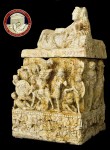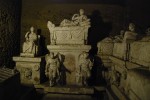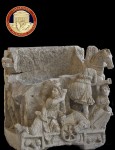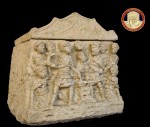 The Italian Carabinieri Tutela Patrimonio Culturale unit (a national police squad dedicated to investigating stolen art and antiquities) revealed on Thursday that they have recovered a massive trove of looted Etruscan artifacts. The stand-out pieces are 23 travertine funerary urns from the 3rd to 2nd century B.C., identified from their inscriptions as having all been stolen from a single Etruscan tomb in Perugia, in the central Italian region of Umbria, belonging to the patrician Cacni family. Most of the urns are decorated in high relief with battle scenes, tauromachia (bullfighting), friezes and representations of the myth of Iphigenia who was sacrificed by her father Agamemnon so that his fleet could sail for Troy.
The Italian Carabinieri Tutela Patrimonio Culturale unit (a national police squad dedicated to investigating stolen art and antiquities) revealed on Thursday that they have recovered a massive trove of looted Etruscan artifacts. The stand-out pieces are 23 travertine funerary urns from the 3rd to 2nd century B.C., identified from their inscriptions as having all been stolen from a single Etruscan tomb in Perugia, in the central Italian region of Umbria, belonging to the patrician Cacni family. Most of the urns are decorated in high relief with battle scenes, tauromachia (bullfighting), friezes and representations of the myth of Iphigenia who was sacrificed by her father Agamemnon so that his fleet could sail for Troy.
 An astonishing 3,000 more artifacts were recovered in this sting, dubbed Operation Iphigenia. Other Etruscan pieces from the Cacni tomb include a sarcophagus lid from the 4th century B.C., a bronze helmet, greave, shield, strigil and an extremely rare bronze kottabos, a Greek drinking vessel used to play a game popular at feasts and symposia involving the throwing of the wine lees at a target. Not all the artifacts are Etruscan; police also recovered thousands of other antiquities and ceramic fragments from the Middle Ages.
An astonishing 3,000 more artifacts were recovered in this sting, dubbed Operation Iphigenia. Other Etruscan pieces from the Cacni tomb include a sarcophagus lid from the 4th century B.C., a bronze helmet, greave, shield, strigil and an extremely rare bronze kottabos, a Greek drinking vessel used to play a game popular at feasts and symposia involving the throwing of the wine lees at a target. Not all the artifacts are Etruscan; police also recovered thousands of other antiquities and ceramic fragments from the Middle Ages.
 Officials call it without exaggeration the greatest Etruscan find since the last hypogeum — the Cai-Cutu tomb also in Perugia — was discovered in 1982, and it came very close to disappearing forever into the black market before anyone knew the artifacts existed. In fact, seven of the 23 urns were already in private hands when the police tracked them down, sold by the looters through middlemen to collectors practiced in the asking of no questions.
Officials call it without exaggeration the greatest Etruscan find since the last hypogeum — the Cai-Cutu tomb also in Perugia — was discovered in 1982, and it came very close to disappearing forever into the black market before anyone knew the artifacts existed. In fact, seven of the 23 urns were already in private hands when the police tracked them down, sold by the looters through middlemen to collectors practiced in the asking of no questions.
Operation Iphigenia started two years ago in Rome with the confiscation of a small travertine head and a picture. A person known by the police to traffic in black market antiquities was attempting to sell an Etruscan urn. He was shopping around a picture of the urn and the little head, removed from the urn in a creepy kidnapper way to prove to potential buyers that he was in possession of the artifact. The head was examined by an expert at the University of Rome Tor Vergata who identified its likely origin as an Etruscan tomb in the Perugia area.
 Perugia was one of the 12 major Etruscan cities and is rich in funerary remains, most famously the Palazzone necropolis, a vast network of subterranean tombs dating from the 6th-5th century B.C. onwards. The Hypogeum of the Volumnis is an elaborate family tomb containing a number of cinerary urns similar in style to the one in the photograph. With the collaboration of the Superintendence for Archaeological Goods of Umbria, police focused their efforts on finding the source of the pictured urn in Perugia.
Perugia was one of the 12 major Etruscan cities and is rich in funerary remains, most famously the Palazzone necropolis, a vast network of subterranean tombs dating from the 6th-5th century B.C. onwards. The Hypogeum of the Volumnis is an elaborate family tomb containing a number of cinerary urns similar in style to the one in the photograph. With the collaboration of the Superintendence for Archaeological Goods of Umbria, police focused their efforts on finding the source of the pictured urn in Perugia.
 Investigations kicked into high gear last February when Perugian court prosecutor Paolo Abbritti coordinated increased surveillance of several people in the construction industry thought to be connected to the traffic in antiquities. The construction guys turned out to be more than just involved in the sales; they made the initial finds during work on a villa 10 years ago.
Investigations kicked into high gear last February when Perugian court prosecutor Paolo Abbritti coordinated increased surveillance of several people in the construction industry thought to be connected to the traffic in antiquities. The construction guys turned out to be more than just involved in the sales; they made the initial finds during work on a villa 10 years ago.
Instead of reporting the discovery to the authorities so the site could be properly excavated and the artifacts claimed by the Perugia archaeological museum, at least one crew member and the boss conspired to keep the pieces for sale on the black market. (It’s a little looter karma that it took them 10 years to sell just seven of the 23 urns and got caught in the attempt to sell the eighth. Yet again, thieves find it’s a lot harder to make a killing from the illegal sale of antiquities than they imagined when they first looked at an ancient artifact and saw dollar signs.)
 The 16 urns not in private hands and the other Etruscan artifacts were found by authorities still hidden in the tomb. The find site is now in the process of being excavated by archaeologists from the Superintendence of Perugia. They expect to find more subterranean tombs connected to the Cacni chamber so this one discovery, already so hugely significant, is likely to lead to even more.
The 16 urns not in private hands and the other Etruscan artifacts were found by authorities still hidden in the tomb. The find site is now in the process of being excavated by archaeologists from the Superintendence of Perugia. They expect to find more subterranean tombs connected to the Cacni chamber so this one discovery, already so hugely significant, is likely to lead to even more.
Five men have been arrested and charged for the looting and trafficking. One is the construction firm owner, another a construction worker and three middlemen who arranged the sales. It sure would be nice if those seven jerks who bought the urns felt the sharp kiss of the legal lash, but that doesn’t seem to be on the agenda right now.
𐌘𐌀𐌍𐌕𐌀𐌔𐌕𐌉𐌊 𐌐𐌏𐌔𐌕 𐌈𐌀𐌍𐌊 𐌖𐌏𐌖
———–
Did they write anything special onto their coffins ? It seems as if they wrote from right to left, but I cannot properly read it.
:hattip:
Etruscan writing and alphabet: http://en.wikipedia.org/wiki/Etruscan_language
I am an embezzler who stole from my family and I’m delighted to read of other thieves.
We all are members of the same family who all steal from one another. Though when certain “figure heads” of the family steal they have no bad karma associated with this because they are the “authorities” who are aloud to stick their hands in pots they neither made nor discovered.
i.e. The German archaeologists who lied after finding Nefertiti in 1914, in their report claimed only to have found a “plaster princess”
succeeded in claiming the bust for their “family” and to this day they have reaped all the rewards of this lie, All are apparently happy with this, because when officials lie cheat and loot all we are able to do is smile.
Never mind the money that trades hands with these higher ups. Of course we must condone it because it is only customary that rights should be reserved for these untouchables.